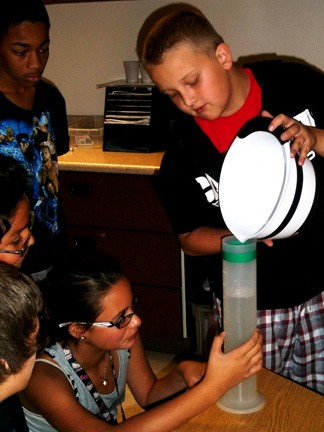A UA program is teaching K-12 students in the region about the benefits of water conservation.
Arizona Project WET educates students, as well as their parents and teachers, about ways be more water efficient through its School Water Audit Program. With offices in Pima, Pinal and Maricopa counties, Arizona Project WET operates a similar program with Phoenix schools called the Water Investigations Program, which is funded by the Nature Conservancy.
Like the WIP, the School Water Audit Program is intended to educate the public about Arizona water issues and ways to conserve. Based out of Tucson, SWAP will use volunteer UA students to conduct a water audit, an interactive presentation, at Canyon Del Oro High School later this month.
“We’re trying to get students to connect with where the water that comes out of their faucet comes from,” said Kerry Schwartz, director of Arizona Project WET, a component of UA’s Water Resources Research Center.
With a curriculum that spans the course of one school year, the WIP is intended to extend students’ knowledge about water conservation through water audits as well as with field trips in which pupils put their water-saving skills to the test. This type of practical education is becoming increasingly favored by teachers, Schwartz said.
“The idea is not to do those things separately, but to do them together around a real world, relevant issue,” Schwartz said. “That is what’s going to stimulate students to think creatively and critically.”
The programs begin by educating the teachers participating in the project on the unique water issues facing Arizona and the Southwest as a whole.
The teachers then “take that information to their classes,” said Tara Oakes, community coordinator for the WIP.
“It really is a ripple effect,” Oakes said. “If we can plant those ideas now with students that water is a limited resource that needs to be protected, then we can start making positive changes for the future.”
To supplement the information the teachers provide to their students, Oakes gives presentations to teach students about topics like groundwater systems and water-efficient technology.
“I always phrase it to the students as, ‘We’re doing an experiment at their school,’” Oakes said.
During the water audit, the students examine water faucets in their school to determine their rates of flow. They then remove the aerator, the attachment at the end of the faucet that houses a mesh screen, and replace it with a water-efficient one. The students then measure the new flow rate and compare it to the first measurement, Oakes said.
“When you change that, it uses less water,” she said. ”Then we can calculate — just by changing that one little … piece of equipment, which costs a couple bucks — how much water you can actually save during a year.”
Oakes said the replacement aerators frequently save schools hundreds of dollars in water costs.
The culminating event of the WIP is a spring field trip in which students get to turn theory into practice.
At a riparian area, such as the Rio Salado Habitat Restoration Area, the students engage in experiments they designed. The experiments range from pH testing to the identification of invertebrates, like insects, in the soil to determine the “health” of the river system, said Peter Bartanen, who teaches seventh and eighth grade science at Griffith Elementary School in central Phoenix.
Bartanen, who is collaborating with the WIP for the third straight year, said that the program endows students with science skills that will be critical for them in the future.
“It teaches them how to be problem solvers,” Bartanen said. “It teaches them how to think about real world issues and how their actions impact everybody else, and it gives kids a good opportunity to engage in science in a hands-on and meaningful way.”
– Follow Mark Armao @MarkArmao









